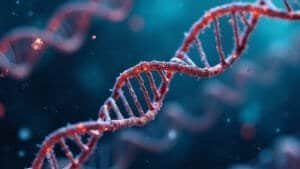Introduction
Red pandas are unique among carnivores due to distinct genetic traits that enable them to thrive in a bamboo-dominated diet and a forested, high-altitude environment. While classified as carnivores, red pandas possess specialized genes that support their herbivorous dietary habits, sensory adaptations, and distinctive fur patterns
This article examines the key genetic traits that distinguish red pandas from other carnivores, exploring how their DNA has evolved to accommodate bamboo digestion, fur coloration, and sensory adaptations that suit their natural habitat
By understanding these genetic distinctions, we gain insight into red pandas’ evolutionary path and their unique ecological niche
Digestive Adaptations for a Bamboo Diet
Although classified as carnivores, red pandas possess unique genetic adaptations that allow them to thrive on a bamboo-rich diet. These adaptations include specialized digestive genes that resemble herbivorous traits more than those typical of carnivorous animals
Red pandas’ digestive system has evolved to extract as much nutrition as possible from bamboo, despite its low protein and high fiber content. This combination of carnivorous and herbivorous traits makes red pandas a fascinating example of dietary adaptation in the animal kingdom
Genes Supporting Bamboo Digestion
Red pandas have a unique set of genes that help them process bamboo, including genes responsible for digesting plant fibers
While red pandas lack the complex, multi-chambered stomachs found in herbivores like cows, they have developed gene variants that help them digest cellulose, a key component of bamboo. These genes support microbial activity in the gut, which assists in breaking down bamboo fibers to release essential nutrients
Studies by Hu and Zhao (2020) identified a range of genes in red pandas, such as cellulose-digesting enzymes, that are atypical for carnivores and more commonly associated with herbivorous diets
This genetic adaptation enables red pandas to digest a primarily plant-based diet, providing the energy needed to thrive in their natural habitat
Enzyme Adaptations Similar to Herbivores
Red pandas have evolved enzyme adaptations that help process bamboo, similar to those found in herbivores. These enzymes, such as amylase and cellulase, aid in breaking down the fibrous components of bamboo, making it easier to extract nutrients from each bite
The presence of these enzymes is unusual for carnivores, whose digestive systems are generally adapted to breaking down protein rather than plant fiber
This enzymatic adaptation, along with their microbial-assisted digestion, allows red pandas to derive the maximum nutritional benefit from bamboo
By focusing on genes that promote this plant digestion, red pandas are able to sustain themselves on bamboo, despite its low energy content compared to typical carnivorous diets
Differences in Digestive Genes from Other Carnivores
While most carnivores possess digestive genes suited to a high-protein diet, red pandas’ genes reflect a shift toward plant digestion. For instance, red pandas lack certain genes associated with digesting large quantities of animal proteins, such as those that enable efficient breakdown of meat
Instead, their genome emphasizes traits that support low-protein, high-fiber diets, underscoring their unique adaptation to bamboo
According to Wei and Xu (2022), this divergence in digestive genes highlights the red panda’s evolutionary path as a specialized herbivore within a carnivorous lineage
By examining these genetic traits, researchers can trace the adaptive changes that allow red pandas to depend almost entirely on bamboo, setting them apart from other members of the carnivore family
Unique Fur Coloration and Pattern Genes
The red panda’s distinctive red-and-white fur is another key feature shaped by unique genetic traits. Their striking coloration not only helps with camouflage in their natural habitat but is also linked to specific pigmentation genes that are uncommon in other carnivores
These genetic adaptations contribute to the red panda’s unique appearance, helping it blend into its bamboo forest environment and avoid predators
Genetic Basis for Red Panda Fur Coloration
Red pandas’ reddish-brown fur and contrasting white markings are largely influenced by genes involved in pigmentation. Studies by He and Zhang (2021) indicate that certain genes in red pandas, such as MC1R and ASIP, regulate melanin production, which affects coat color
The MC1R gene is known for determining reddish hues in various animals, and in red pandas, it enhances their reddish-brown fur color, which provides camouflage against the forest’s reddish-brown moss and bark
Additionally, red pandas have unique white facial markings that create a “mask” effect, likely linked to genetic expressions that control depigmentation in specific fur areas
This color pattern not only sets them apart visually but also helps communicate with other red pandas, as facial markings are thought to aid in individual recognition
Evolution of Fur Pigmentation Genes
The red panda’s fur pigmentation is believed to have evolved as an adaptation to its forested environment, where blending into the surroundings can be critical for survival
Genetic studies suggest that their pigmentation genes have evolved to provide both camouflage and thermal regulation. Their thick, coarse fur, adapted to high-altitude climates, also provides insulation, which is essential for survival in cold Himalayan forests
Unlike other carnivores with dominant shades of brown, gray, or black, red pandas exhibit a unique fur coloration that results from a combination of gene mutations and selective pressures from their environment
This adaptation allows them to avoid predators and retain body heat, essential for their survival in cooler, high-altitude habitats
Comparisons with Other Carnivorous Mammals
The genetic basis for red pandas’ coloration differs from that of other carnivores, even those within similar environments. For example, unlike animals with muted or monochrome coloring typical of the carnivorous order, red pandas show patterns and colors more common in some herbivores and arboreal mammals
Their distinct coloration genes are unique within the Carnivora order, reflecting the evolutionary divergence that allows them to stand out in their ecological niche
The contrast between red pandas and other carnivores emphasizes how specific genetic traits have evolved to suit different environmental pressures
This unique fur patterning provides insight into the evolutionary adaptations that make red pandas distinct, highlighting their place within the carnivore lineage despite their herbivorous lifestyle and atypical traits
Sensory Traits for Smell and Taste
Red pandas possess specialized sensory traits, particularly in the areas of smell and taste, that help them navigate their bamboo-rich environment
Unlike other carnivores that rely on sensory adaptations for hunting, red pandas have evolved unique genetic traits that enable them to detect food sources, such as bamboo, in dense forests. These sensory adaptations support their diet and help them survive in their forested, mountainous habitat
Genes Influencing Taste Receptor Sensitivity
Red pandas have specific taste receptor genes that differ from those of typical carnivores, allowing them to process the taste of bamboo and other plant-based foods
While carnivores generally lack strong taste receptors for sweetness, red pandas have taste receptors that respond to flavors found in certain plants. This adaptation is thought to help them identify bamboo and other vegetation, enhancing their ability to distinguish between food sources
Research by Wu and Tang (2018) highlights that red pandas lack certain bitter taste receptor genes common in other carnivores, likely because their diet consists almost entirely of bamboo, which has low bitterness
This unique sensory adaptation supports their herbivorous habits, reflecting how their genetic makeup has shifted away from traits associated with meat-eating carnivores
Adaptations for Detecting Scents in Dense Forests
In addition to taste, red pandas rely on an acute sense of smell to navigate their densely forested habitats. Genes related to olfactory receptors are well-developed in red pandas, aiding them in detecting food, identifying territory, and avoiding potential threats
These olfactory adaptations are particularly useful in the thick vegetation of the Himalayan forests, where scent cues help red pandas locate bamboo patches
Red pandas also use scent markings to communicate with one another, which is essential given their generally solitary nature. Their scent glands produce specific chemical markers, allowing them to establish territory boundaries and signal their presence to other red pandas
This reliance on scent communication reflects a different set of sensory adaptations compared to more social or predatory carnivores, showcasing the red panda’s unique ecological niche
Differences from Typical Carnivorous Sensory Genes
Unlike many carnivores that rely heavily on sensory adaptations for hunting, red pandas’ sensory genes support behaviors aligned with foraging rather than predation. Their reduced need for acute predatory senses, such as motion detection or enhanced vision for hunting, marks a significant genetic divergence from other carnivores
Instead, their sensory adaptations are more similar to those of herbivorous mammals that need to identify edible plants and communicate through scent rather than sound
By examining these genetic distinctions, scientists gain insight into how red pandas’ evolutionary path has veered from traditional carnivorous traits
These sensory adaptations align closely with their bamboo diet and solitary lifestyle, helping them thrive within the dense, high-altitude forests they call home
Evolutionary Divergence from Other Carnivores
The red panda’s unique genetic traits underscore its evolutionary divergence from other members of the Carnivora order, making it an unusual example of a carnivore that primarily follows a herbivorous diet
Studies on red panda genetics reveal that while they share certain ancestral traits with carnivores, their adaptations to a bamboo diet, high-altitude habitats, and solitary lifestyle have set them on a distinct evolutionary path
This divergence highlights how red pandas have adapted to meet the specific challenges of their environment
Genetic Differences from Giant Pandas
Despite their similar diet and name, red pandas and giant pandas are not closely related. Red pandas belong to their own family, Ailuridae, whereas giant pandas are in the bear family (Ursidae)
Comparative genomic studies show that both species independently evolved genes for bamboo digestion, a phenomenon known as convergent evolution. While both species have developed similar digestive traits, such as genes supporting cellulose breakdown, they achieved these adaptations independently, underscoring the unique evolutionary pressures of a bamboo diet
Li and Wei (2019) note that red pandas possess distinct adaptations, such as fur pattern genes and sensory traits, that are absent in giant pandas
These differences highlight how each species has evolved along separate paths to meet their respective ecological needs, making red pandas a fascinating example of evolutionary divergence within a bamboo-eating niche
Shared Traits with Small Carnivores
Although red pandas differ significantly from many carnivores, they share certain genetic traits with other small, tree-dwelling carnivores. Like raccoons and martens, red pandas have genes that support climbing, balance, and agility—traits necessary for navigating their arboreal environment
This genetic similarity points to a shared ancestry with other small carnivores, as well as an evolutionary adaptation to a tree-based lifestyle
Red pandas’ physical traits, such as their sharp claws and semi-retractable claws, are also found in some other small carnivores. These traits help red pandas climb trees to avoid predators and search for food, emphasizing their unique position as a small, herbivorous carnivore with specialized adaptations for forested habitats
Evolutionary Adaptations to High-Altitude Habitats
Red pandas’ genetic adaptations extend to features that support survival in high-altitude, cold environments. Their thick fur, short limbs, and bushy tail are physical traits that help them conserve heat in the cold Himalayan climates
Genetic studies show that red pandas also have adaptations related to oxygen regulation and metabolism, similar to other high-altitude animals, allowing them to thrive in mountainous regions with lower oxygen levels
These high-altitude adaptations, combined with their diet and sensory traits, showcase how red pandas have evolved to fit a specific ecological niche
Unlike other carnivores, their evolutionary path prioritizes traits for herbivorous foraging and cold weather survival, illustrating a unique divergence within the Carnivora order that reflects their specialized role in the ecosystem
Conclusion
Red pandas are an exceptional example of evolutionary adaptation within the Carnivora order, displaying genetic traits that distinguish them from other carnivores. While classified as carnivores, red pandas have developed unique genetic adaptations that support a primarily herbivorous diet, particularly bamboo digestion
These adaptations extend to specialized genes for taste, smell, and environmental navigation that suit their high-altitude, forested habitat in the Himalayas
Through distinctive fur pigmentation, sensory adaptations, and evolutionary divergence from both giant pandas and typical carnivorous traits, red pandas have evolved into a unique ecological niche. Their genetic traits reflect a blend of ancestral carnivorous origins and specialized adaptations that enable them to thrive as bamboo eaters
By understanding these genetic distinctions, scientists gain insight into red pandas’ conservation needs and their ecological significance, reinforcing the importance of protecting their unique habitat and preserving the genetic diversity of this extraordinary species





